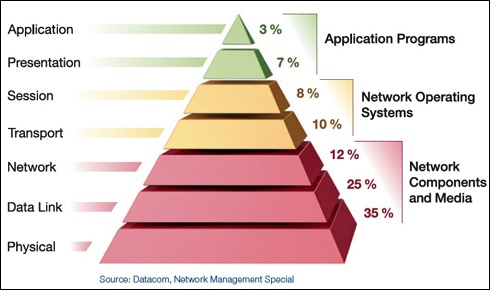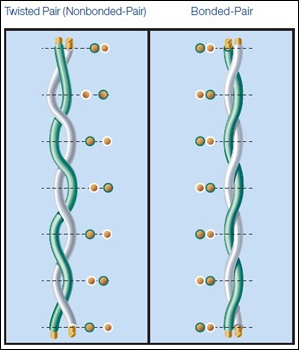5 Steps to Selecting the Right Industrial Ethernet Cable
Industrial Ethernet networks are becoming more sophisticated as organizations strive for high reliability and performance plus seamless data access and reporting. Flat networks are evolving into managed infrastructure and there are many new technologies, such as redundancy using PRP (Parallel Redundancy Protocol) to consider.
However, basic principles still apply and one of these is that it is essential to use the right industrial Ethernet cable to achieve reliable performance. Network components and media are the cause of over 70% of all network faults, with operating systems accounting for fewer than 20% of failures and application programs for the rest. Furthermore, when cable failures occur, they are often difficult to diagnose and resolve.

When the cost of cabling is compared to the high costs of network failure, which can be thousands of dollars per minute, it is abundantly clear that it makes good financial sense to select and install the right cable for the application. This article outlines the 5 key steps to selecting the right industrial Ethernet cable.
Displayed to the left is the OSI Model showing the layers of communication systems and where network failures occur. Network components and media account for more than 70% of failures.
Industrial Applications Require Industrial Cable
In a typical office, the Ethernet infrastructure is installed in a relatively clean, quiet environment with cables hidden behind walls, in ceilings or under floors and network switches, hardware and connectivity components sheltered in protected areas.
However, industrial facilities present a very different reality. Here, many if not most cables, connectors, switches, and active network components are integral to machine automation, instrumentation and control systems, which places them in harsh and potentially hazardous situations.
Even the best Commercial-Off-The-Shelf (COTS)Ethernet systems are not made to handle such conditions over time. Rugged conditions call for ruggedized cables and only industrial-grade Ethernet system components are built tough enough to withstand the hazards and risks they are exposed to day after day.
1. Industrial Ethernet Cable Selection: Flex and Environmental Factors
The first step is to understand the flex and environmental requirements of the application:
- Cabinet or control rooms / low vibration: For enclosed environments, where vibration is limited. In these applications, a solid conductor is the right choice, future-proofed with high bandwidth capability.
- Factory floors / moderate vibration: For the factory floor and work areas where there are raised levels of vibration. Cables are also likely to be exposed to oil, chemicals, rough handling, abrasion, UV radiation, temperature variations, and electronic noise (EMI and RFI).
- On machine / high vibration: For use on machines, where vibration and temperatures are high to very high. In this case the need is for highly flexible cabling resistant to trailing and torsion, as well as a high level of connectivity protection against liquids (M12 with IP67 and IP68 protection).
2. Industrial Ethernet Cable Selection: Data Rate Requirements
Use the table below to determine the correct cable for the data transmission rates you need:
| Data Rates | Up to 100 Mb/s | Up to 1 Gb/s | Up to 10 Gb/s |
| Channel Class ISO/IEC 11801 | Class D | Class D | Class E |
| Belden Recommended Cable Category | Cat 5e (2 pr) | Cat 5e (4pr) | Cat6A |
| Belden Recommended Patch Cord Category | Cat 5e (2pr) | Cat 5e (4pr) | Cat6A |
Fig. 2: Different types of cable are needed to achieve different data transmission rates.
3. Industrial Ethernet Cable Selection: Jacket Options
Again, depending on your application, selecting the right jacket material for your cable will ensure the best performance.
| Function | PVC | FRNC | TPE | PUR |
| Oil Resistance | ** | ** | *** | *** |
| Abrasion Resistance | ** | * | *** | **** |
| Continuous Flex | ** | * | **** | **** |
| Specific Attributes | General purpose, good mechanical strength | Flame retardant, low smoke when burned | Excellent for flexing applications and very good resistance to oils and coolants | Outstanding resistance to abrasion, high flex and high tolerance to solvents |
| Cost of Installation | $ | $$ | $$$ | $$$ |
| Type of Application | Permanent Installation | Permanent Installation | Continuous Flexing | Moderate Flexing |
| Moderate Flexing | Moderate Flexing | Continuous Flexing | ||
| Legend | *=Fair, **=Good, ***=Excellent, ****= Outstanding | |||
Figure 3: Chart showing application requirements and appropriate jacket materials for them.
4. Industrial Ethernet Cable Selection: Shielded versus Unshielded
Unshielded cables can be used in most environments; shielded cables are recommended for especially high noise environments. Shielding is usually achieved when a foil or braid is used to protect the integrity of the signal and to screen out any undesirable interference or noise. However, to provide extra durability and noise protection, a foil or braid combination can be used.
5. Industrial Ethernet Cable Selection: Twisted or Bonded-Pair Conductors
There are 2 aspects to this characteristic of cables. The first aspect is solid versus stranded conductors and the considerations and options for this were given in step 1.

The second aspect is twisted pair versus bonded-pair construction. Bonded-pair cables provide resistance to the rigors of installation by utilizing a manufacturing technique that affixes the insulation of the cable pairs along their longitudinal axes so no gaps can develop between the conductor pairs.
Twisted pair cable construction can be susceptible to pair-gapping during installation as well as impedance mismatches.
Belden has developed proprietary bonded-pair technology that provides:
- Uniform conductor-to-conductor spacing, or centricity due to the absence of gaps between the conductor pairs.
- Superior electrical performance thanks to the uniform centricity. Installation processes such as bending, pulling and twisting do not affect the high functioning of this cable.
Image on the right showing twisted pair conductors have gaps which decrease performance. Belden’s patented bonded-pair technology maintains electrical performance even when cable is bent, pulled or twisted.
Choosing the right cable can make the difference between success and failure of the system. But if you choose the wrong cable, you’ll never get it right.
Know Your Application, Then Select Your Cable
Avoiding expensive network failures requires matching your application requirements to the appropriate cable characteristics. Once the right industrial Ethernet cable is specified, make sure it is the one that is actually installed. Doing this ensures that your mission-critical operation is properly equipped to achieve maximum dependability and performance.
